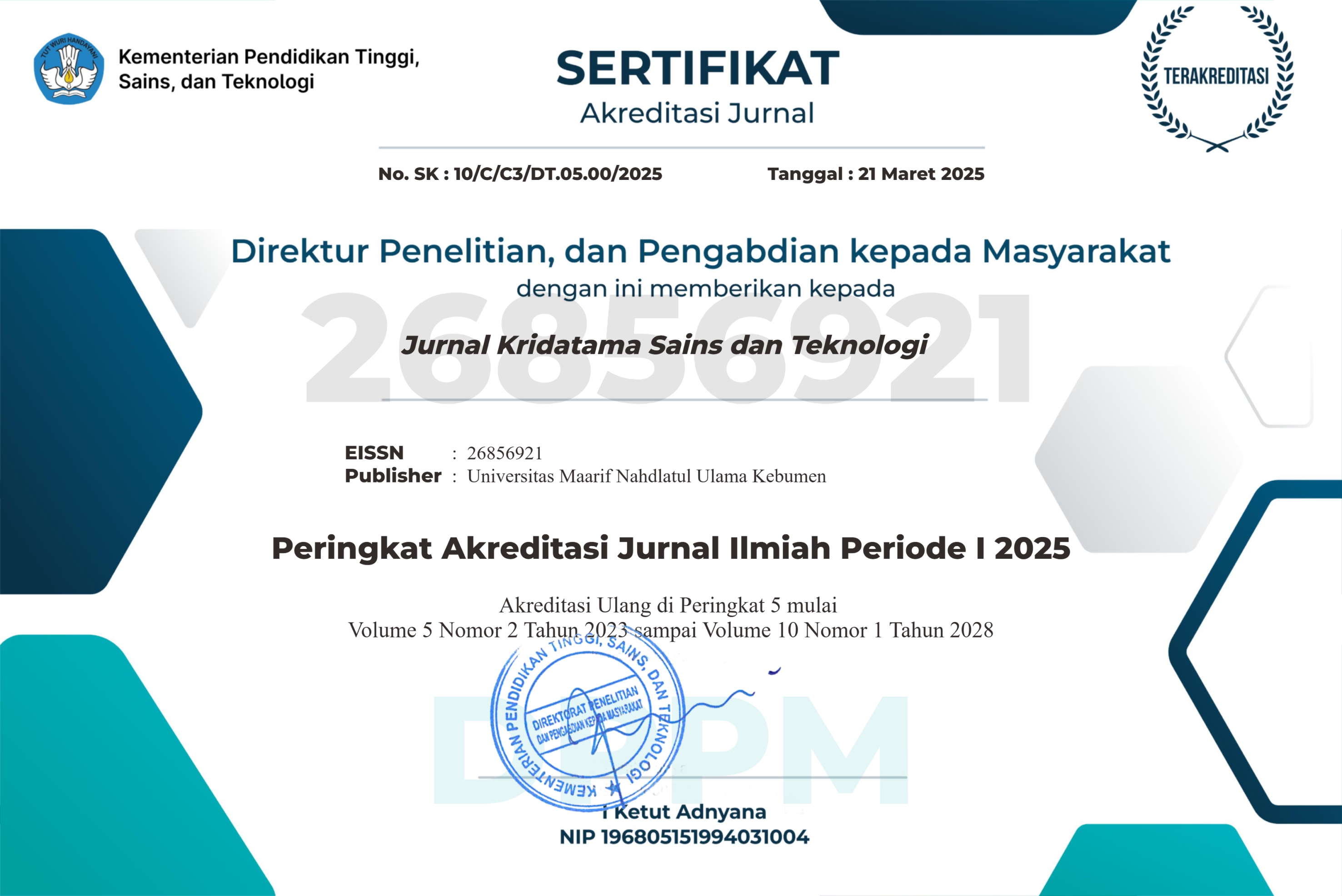Karakteristik Mortar Komposit Dengan Penambahan Arang Aktif
DOI:
https://doi.org/10.53863/kst.v7i01.1561Keywords:
Activated Charcoal, Cement, Density, Mechanics, DurabilityAbstract
The addition of activated charcoal to the cement matrix can increase the density and durability of the mortar. The purpose of this study was to analyze the effect of activated charcoal on the characteristics of composite mortar including compressive strength, density, and water absorption. Making mortar composite with the composition of activated charcoal to the weight of cement (1%, 2%, 3%, 4%, and 5%), the ratio of cement and sand is 1: 3. The composition will be tested and analyzed for its effect on the compressive strength, density, and water absorption of mortar composite. The results showed that the addition of activated charcoal did not have a significant effect on the characteristics of mortar composite, except for the setting density. The addition of activated charcoal by 5% showed an optimal composition with a compressive strength value of 11.67 MPa, a setting density of 2092.91 kg / m3, an oven-dry density of 1853.93 kg / m3, and a water absorption of 15.20%
References
American Society for Testing and Materials. (2008). Standard specification for mortar for unit masonry (ASTM C270). Philadelphia, PA: ASTM International.
Alderete, N. M., Zaccardi, Y. A., & De Belie, N. (2020). Mechanism of long-term capillary water uptake in cementitious materials. Cement and Concrete Composites, 106, 103448. https://doi.org/10.1016/j.cemconcomp.2019.103448
Asadi, I., Shafigh, P., Hashemi, M., Akhiani, A. R., Maghfouri, M., Sajadi, B., Mahyuddin, N., Esfandiari, M., Talebi, H. R., & Metselaar, H. S. C. (2020). Thermophysical properties of sustainable cement mortar containing oil palm boiler clinker (OPBC) as a fine aggregate. Construction and Building Materials, 268, 121091. https://doi.org/10.1016/j.conbuildmat.2020.121091
Babar, A. A., Panhwar, I., Qureshi, S., Memon, S., & Siddiqui, Z. (2019). Utilization of biomass (rice straw) to produce activated charcoal through single stage pyrolysis process. Journal of International Environmental Application & Science, 14(1), 1–6.
Badan Standarisasi Nasional. (2002). Metode pengujian kekuatan tekan mortar semen portland untuk pekerjaan sipil (SNI 03-6825-2002). Jakarta: Badan Standarisasi Nasional.
Badan Standarisasi Nasional. (2002). Tata cara perhitungan struktur beton untuk bangunan gedung (Beta version) (SNI 03-2847-2002). Jakarta: Badan Standarisasi Nasional.
Benabed, B., Soualhi, H., Ase, B., Azzouz, L., Kadri, E., & Kenai, S. (2016). Effect of limestone powder as a partial replacement of crushed quarry sand on properties of self-compacting repair mortars. Journal of Building Materials and Structures, 3(1), 15–30. https://doi.org/10.34118/jbms.v3i1.21
Dagu, C. D., Yang, X., Yingkong, S., Paul, S. C., Susilawati, & Wong, L. S. (2020). Mechanical and thermal properties of lightweight concrete incorporated with activated carbon as coarse aggregate. Journal of Building Engineering, 31, 101347. https://doi.org/10.1016/j.jobe.2020.101347
Dzigita, N., Girskas, G., & Gintautas, S. U. (2017). Properties of concrete modified with mineral additives. Construction and Building Materials, 135, 37–42. https://doi.org/10.1016/j.conbuildmat.2016.12.215
Ehsani, A., Nili, M., & Shaabani, K. (2017). Effect of nanosilica on the compressive strength development and water absorption properties of cement paste and concrete containing fly ash. KSCE Journal of Civil Engineering, 21(5), 1–12. https://doi.org/10.1007/s12205-016-0853-2
Ersan, Y. C., Da Silva, F. B., Boon, N., Verstraete, W., & De Belie, N. (2015). Screening of bacteria and concrete compatible protection materials. Construction and Building Materials, 88, 196–203. https://doi.org/10.1016/j.conbuildmat.2015.04.027
Falliano, D., De Domenico, D., Ricciardi, G., & Gugliandolo, E. (2019). Compressive and flexural strength of fiber-reinforced foamed concrete: Effect of fiber content, curing conditions and dry density. Construction and Building Materials, 198, 479–493. https://doi.org/10.1016/j.conbuildmat.2018.11.197
Farghali, M., Osman, A. I., Umetsu, K., & Rooney, D. W. (2022). Integration of biogas systems into a carbon zero and hydrogen economy: A review. Environmental Chemistry Letters, 20, 2853–2927. https://doi.org/10.1007/s10311-022-01468-z
Gu, L., Liu, T., Wu, K., Yang, Z., Wen, Z., Zhang, Z., & Li, H. (2022). Temperature-dependent water retention and bleeding of fresh cement-based materials with VEAs. Cement and Concrete Composites, 130. https://doi.org/10.1016/j.cemconcomp.2022.104539
Hatungimana, D., Taskopru, C., Ichedef, M., Sac, M. M., & Yazıcı, S. (2019). Compressive strength, water absorption, water sorptivity and surface radon exhalation rate of silica fume and fly ash based mortar. Journal of Building Engineering, 23, 369–376. https://doi.org/10.1016/j.jobe.2019.01.011
Heidari, A., Hashembour, M., Javdanian, H., & Karimian, M. (2018). Investigation of mechanical properties of mortar with mixed recycled aggregates. Asian Journal of Civil Engineering, 19(5), 583–593. https://doi.org/10.1007/s42107-018-0044-1
Hendriko, A., Juwono, A. L., Budiman, I., Subyakto, Soegijono, B., Sadir, M., Sudarmanto, Purnomo, D., Narto, Akbar, F., Setyolisdianto, J. A., & Kristianto, M. A. (2023). Mechanical and thermal properties of non-structural adhesive mortar using linear low-density polyethylene (LLDPE) with vinyl acetate/ethylene (VAE) interface. Colloid and Polymer Science. https://doi.org/10.1007/s00396-023-05216-9
Huang, Q., & Zhao, L. (2019). Correlation between compressive strengths and water absorption of fly ash cement mortar immersed in water. Archives of Civil Engineering, 65(3), 141–152. https://doi.org/10.2478/ace-2019-0040
Huang, Q., Wang, C., Yang, C., Zhou, L., & Yin, J. (2015). Accelerated sulfate attack on mortars using electrical pulse. Construction and Building Materials, 95, 875–881. https://doi.org/10.2478/ace-2019-0040
Jung, C. T., Siang, T. C., Kwong, T. H., & Boon, K. H. (2019). Compressive strength and water absorption of mortar incorporating silica fume. International Journal of Civil Engineering (SSRG-IJCE), 6(8), 39–43. https://doi.org/10.14445/23488352/IJCE-V6I8P106
Khalil, M. Y., & Fawzy, A. A. (2020). Mechanical, microstructural and absorption properties of cement mortar containing different types of nano-clay. Construction and Building Materials, 248, 118656. https://doi.org/10.1016/j.conbuildmat.2020.118656
Luhar, S., & Luhar, I. (2022). Durability performance of self-compacting concrete incorporating fly ash and rice husk ash. Case Studies in Construction Materials, 17, e01304. https://doi.org/10.1016/j.cscm.2022.e01304
Machado, M. T. A., Mendes, M. T., Gois, M. R., & Silva, F. D. A. (2016). Evaluation of the properties of cement-based mortars with activated charcoal. Journal of Building Pathology and Rehabilitation, 1, 10. https://doi.org/10.1007/s41024-016-0012-6
Mahrous, B., Sorour, M., Abdelrahman, M., & Khater, H. (2022). Development of sustainable mortar using fly ash and steel slag. Case Studies in Construction Materials, 16, e01012. https://doi.org/10.1016/j.cscm.2022.e01012
Maslehuddin, M., & Shameem, M. (2012). Factors affecting durability of concrete. In Siddique, R. (Ed.), Green concrete: Properties and applications (pp. 155–174). Nova Science Publishers.
Miller, S. A., Horvath, A., & Monteiro, P. J. M. (2016). Readily implementable techniques can cut annual CO₂ emissions from the production of concrete by over 20%. Environmental Research Letters, 11(7), 074029. https://doi.org/10.1088/1748-9326/11/7/074029
Morsy, M. S., Alsayed, S. H., & Aqel, M. (2010). Hybrid effect of carbon nanotube and nano-clay on physico-mechanical properties of cement mortar. Construction and Building Materials, 24(1), 1–8. https://doi.org/10.1016/j.conbuildmat.2009.08.044
Nasution, A. H., Manullang, O. H. H., & Ginting, T. A. (2020). Pemanfaatan karbon aktif dari tempurung kelapa sawit untuk penjernihan air sumur bor. Jurnal Teknik Kimia USU, 9(1), 1–7. https://doi.org/10.32734/jtk.v9i1.3638
Purbasari, H. K., Zainuri, M., & Rahmawati, F. (2017). Sintesis karbon aktif dari limbah biomassa tempurung kelapa sawit dengan aktivator H₃PO₄ dan aplikasi pada adsorpsi fenol. Jurnal Kimia Valensi, 3(2), 132–138. https://doi.org/10.15408/jkv.v3i2.6461
Putra, R. B., Santoso, D. A., & Yuliasih. (2020). Pengaruh variasi kadar karbon aktif terhadap kuat tekan mortar semen. Jurnal Reka Buana, 5(3), 143–147. https://doi.org/10.33366/rekabuana.v5i3.1792
Ramadhani, A. A., Maulana, T., & Gunawan, R. (2017). Pemanfaatan karbon aktif dari cangkang kelapa sawit sebagai adsorben logam berat Pb (timah hitam) pada limbah cair laboratorium. Jurnal Teknik Kimia USU, 6(2), 33–38. https://doi.org/10.32734/jtk.v6i2.4723
Sharma, R., & Bansal, P. (2016). Use of different types of nano silica in self-compacting concrete. Perspectives in Science, 8, 295–297. https://doi.org/10.1016/j.pisc.2016.04.059
Surya, A. B., & Effendy, H. (2019). Pengaruh karbon aktif dari limbah sekam padi terhadap kuat tekan beton. Jurnal Konstruksia, 11(2), 78–83. https://doi.org/10.22216/jk.v11i2.4083
Susanti, I., & Falah, M. (2021). Pengaruh karbon aktif dari kulit pisang terhadap sifat mekanik mortar semen. Jurnal Teknik Sipil dan Lingkungan, 7(2), 114–121. https://doi.org/10.12962/jtsl.v7i2.8729
Zhang, P., Gao, Y., & Xue, X. (2019). Effect of nano-clay on the mechanical properties and durability of cement-based materials. Construction and Building Materials, 211, 303–313. https://doi.org/10.1016/j.conbuildmat.2019.03.229
Downloads
Published
How to Cite
Issue
Section
License
Copyright (c) 2025 Muhammad Sadir, Baiq Mirawati, I Gde Adi Suryawan Wangiyana, Albert Hendriko, Ade Irama, Zoya Saharani Hidayah, Yusron Hafiz

This work is licensed under a Creative Commons Attribution-ShareAlike 4.0 International License.
Authors retain copyright and grant the journal right of first publication with the work simultaneously licensed under a Creative Commons Attribution-ShareAlike 4.0 International License that allows others to share the work with an acknowledgment of the work’s authorship and initial publication in this journal

















